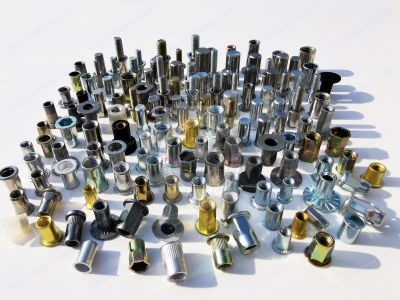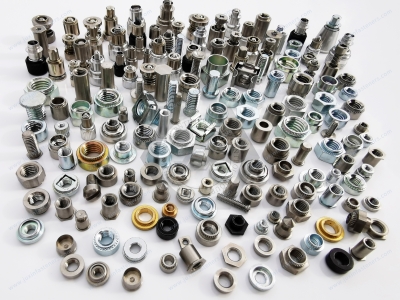Call Us
+86 136 6007 9809
Call Us
+86 136 6007 9809
Nov. 09, 2023
Rivet nuts are divided into pull and compression rivet nuts, which are not unfamiliar to industrial work operators. What are the differences, and which tool should they buy? Pull rivet nuts and pressure rivet nuts have their uses and differences.
Pull rivet nut: known as pull cap or instant pull cap; it is mainly used for all kinds of metal plates, tubes, and other manufacturing industries in the field of fastening; it is now widely used in automobiles, aviation, railways, refrigeration, elevators, switches, instruments, furniture, decorative and other electromechanical and light industrial products on the assembly. To solve the metal sheet, thin tube welding nut easy to melt, thread easy to slip teeth and other shortcomings of the development, it does not need to attack the internal threads, there is no need to weld the nut, riveted firmly and efficiently, but also very convenient to use.
A pressure rivet nut, also known as a self-buckling rivet nut, is applied to sheet metal or sheet metal on a nut. The shape is round, with one end with embossed teeth and a guide groove. The principle is to press into the pre-set holes in the sheet metal through the pressure flower teeth; generally speaking, the diameter of the pre-set holes is slightly smaller than the pressure rivet nut of the pressure flower teeth through the pressure to make the pressure rivet nut flower teeth squeezed into the plate so that the perimeter of the hole resulting in plastic deformation, deformation of the material is pressed into the guiding groove, resulting in the effect of locking.
When should you choose the pressure rivet nut, and when should you use the rivet nut? It depends on whether the applicable conditions are appropriate; the so-called "conditions appropriate" refers to the construction of the thickness of the plate in line with the corresponding specifications of the parameter range of the rivet nut can be used to pressure rivet nut (please refer to our specification table for details, please carefully check the selection of the plate), instead of selecting the rivet nut, the general conditions are not suitable for the situation include, but are not limited to the following Four cases:


1. Flat head blind rivet nut, the cylindrical part is divided into two kinds of glossy and vertical grain, and vertical grain type rivet nut because its vertical grain can play the role of anti-slip; in the production process, is more commonly used one, riveted to the head of the late leakage in the thin plate, flat head rivet nut is also the most widely used rivet nut most solid.
2. Countersunk head blind rivet nuts are also divided into two types of glossy and vertical grain, riveted to the thin plate with chamfer, after installation of its head face parallel to the light plate surface, can supply materials are iron galvanized, 304 stainless steel, 316 stainless steel rivet nuts.
3. Small countersunk head blind rivet nuts are available in galvanized iron, 304 stainless steel, and 316 stainless steel. A small countersunk head blind rivet nut is a head whose outer diameter and thickness are smaller than the countersunk head rivet nut; if the sheet metal is relatively thin, chamfer, do a minor or do not do the chamfer; only use a small countersunk head blind rivet nut can be applied.
4. Hexagonal blind rivet nut material is also divided into iron zinc-plated, 304 stainless steel, 316 stainless steel, supply specifications for the M3-M12, hexagonal rivet nut is also divided into flat hexagonal rivet nut and small head hexagonal rivet nut, installed in the bottom of the hexagonal holes, because of its hexagonal shape, thereby wholly preventing skidding, can withstand a greater degree of torsion, tested even if the threads are damaged, the hexagonal blind rivet nut can be firmly riveted to the riveted nut or the hexagonal blind rivet nut can be used to the riveted nut, or the hexagonal blind rivet nut can be used to the riveted nut. It can be firmly riveted on top of the sheet; it is installed with ordinary round rivet nut installation, which is the same, only in the punch bottom hole to be punched into the bottom hole with the appropriate hexagonal holes.
Rivet nuts are used in railways, refrigeration, elevators, switches, etc. If the nut of a product needs to be installed outside, and inside the space is narrow, can not let the pressure riveting machine's press head enter the pressure riveting and blind pull and other methods can not achieve the strength requirements, then the pressure riveting and riveting are not feasible. It would be best to use riveting, which is suitable for all plate and tube thicknesses (0.5MM-6MM) in the fastening field. Using a pneumatic or manual rivet gun can be riveting, convenient, and firm; instead of the traditional welding nut, to make up for the metal plate, thin tube welding is easy to melt, welding nut is not smooth, and other shortcomings.
1. A construction plate that is too thin, such as only 0.5 mm, or too thick, such as more than 3 mm, strictly speaking, in the field of chassis cabinet processing to achieve such a thickness can not be called a plate.
2. Thin and thick plates have nothing to do with; need to fix the two kinds of plates together;
3. The construction of the space environment does not allow you to use pressure riveting equipment; for example, the plate itself is a particular shape or curvature or bending inside, the shape of the plate is irregular and can not be positioned on the pressure riveting machine, or the plate can not be turned on the pressure riveting machine. Juxin Fasteners suggests that you choose to use the rivet nut rather than the pressure riveting nut.
4. Another critical point: under the same circumstances, with the exact specifications parameters of the rivet nut and rivet nut riveted on the same thickness of the plate, the rivet nut's tensile degree (or tensile force) to be higher, depending on the specific circumstances.
If you are looking for high-quality automotive fastener screws & all kinds of plastic fasteners or technical support for structural design, please get in touch with me. Use our new Product Finder tool, download our Product Catalog, and let us help you get custom parts.adelajonly@gmail.com. Thanks. Website: www.juxinfasteners.com
Contact Us
Tel.:
+86 020 8621 0320
+86 020 3121 6067
Technical Support:
Navigation
SEND INQUIREY